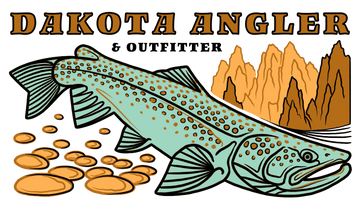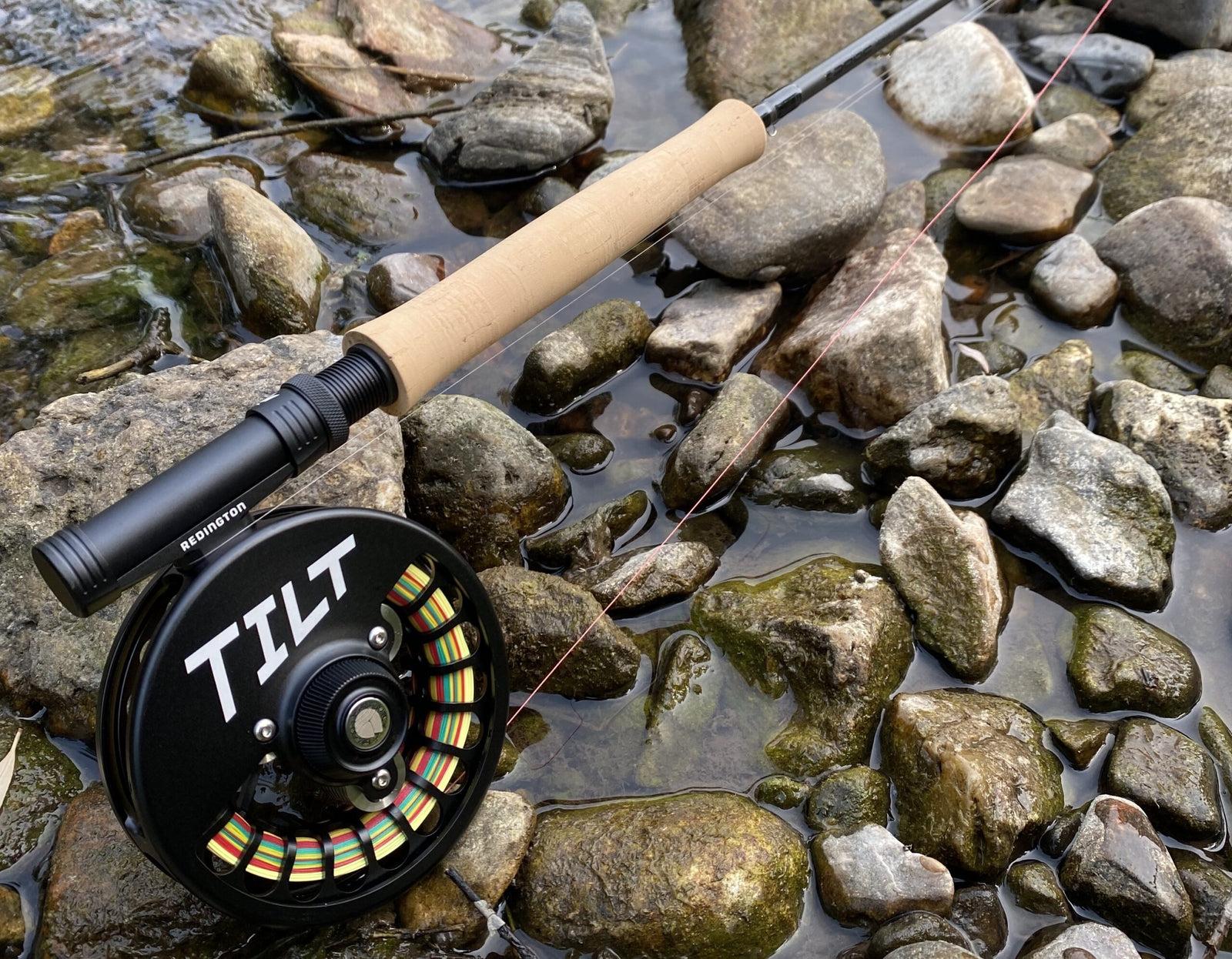
Quick note: Euro Nymphing has evolved and has largely absorbed the terms Czech Nymphing, Polish Nymphing, Spanish Nymphing, and French Nymphing.
What is Euro Nymphing? As with many things in fly fishing, the answer can be long and may contain more details than our increasingly short attention spans can sit through. Let’s try to keep it as simple as possible: Euro Nymphing encompasses techniques developed across Europe during fly fishing competitions. These competitions don’t allow for weights or strike indicators to be added to the leader. A style of nymph fishing evolved that uses heavily weighted flies and thin leaders. When Euro nymphing, anglers aim to maintain the tension between the rod tip and the flies, and this tension allows them to feel strikes and miss fewer fish. They can also watch brightly colored sections of monofilament incorporated into the leader, called sighters, to detect strikes.
Very little to no fly line is cast while Euro Nymphing. Instead, fishing is done with the leader. In a typical Euro nymphing cast, the angler lifts the weight of the flies with the rod tip and “lobs” the weight of the flies towards the target. The weight of the flies carries the thin leader forward, completing the cast. After the flies land and begin to sink to the desired depth, the angler lifts the rod to keep the tension between the weight of the flies and the rod tip. No line or leader is left laying on the water’s surface. The rod is lifted well above the water's surface and the leader stays tight between the flies and the rod tip. Depth is controlled by lifting or lowering the rod.
The angler follows the flies downstream with the rod tip, carefully maintaining the tension the entire length of the drift. The rod can be held almost directly above the nymphs on shorter casts or angled more downstream on longer casts.
When Euro nymphing, it’s all about staying tight and in contact with the flies. The better the angler is at maintaining tension, the easier it is to detect strikes. When a strike is felt or seen, the angler quickly lifts the rod tip to set the hook. If there isn't a fish on the line, the set can be lifted further and turned into a new cast. While Euro Nymphing, it’s important to react quickly and set the hook often. The more hook sets and the quicker the reaction, fewer opportunities will be missed and more fish caught.
Getting Started- Euro Nymphing Equipment
To get the most out of this style of fishing, choosing the right equipment makes a huge difference. There are three key parts to a successful Euro nymphing setup; properly weighted flies, choosing the right leader, and using a rod purposely designed for Euro nymphing.
(While there are "fly lines" designed for Euro Nymphing, they don't really figure that much into fishing technique. Fishing is done with the leader and seldom any fly line outside of the rod tip.)
Flies
Choosing the right flies is very important to your Euro Nymphing rig. This technique is all about fly weight. In Euro nymphing, the angler is casting the weight of the flies. Typically in fly fishing, we cast the weight of the line. Euro Nymphing relies on weighted flies to aid in the cast but also to achieve the sink rate desired for the depth of water fished.
Remember these techniques came out of competitions that forbid the use of split shot or other forms of weight being added to the leader. That means all the weight needs to be incorporated into the nymphs themselves. In order to fish effectively subsurface, flies need to sink and sink quickly.
Early flies for Euro nymphing were often tied on scud style hooks wrapped with lead wire. While these flies are still used and can be effective, the bulk of patterns employed for Euro Nymphing today are tied with tungsten beads on jig style hooks. Tungsten Jig nymphs are ideal because their slim silhouettes sink quickly. The jig hook platform also allows for the same size fly to be tied with a variety of bead sizes allowing anglers to dial in sink rates for different water types.
It’s best to choose a few patterns you have confidence in and have them in different sizes and weights. If you are new to Euro nymphing, a fly pattern such as a Jig Frenchie or Rio’s French Dip is a good place to start.
Different water types require more or less weight. Choose flies that have enough weight to sink in the water you are fishing. Shallow riffles will require less weight than a deep run. You may have to change flies periodically as you work your way upstream.
If you tie your own flies we have plenty of fly tying videos for tungsten jig patterns.
Euro Nymphing Fly Patterns
- Rio’s French Dip
- Rio’s May it Be
- Umpqua Czech Bomb
- Tungsten Jig Pheasant Tail
- Tungsten Jig Hare’s Ear
- Peacock Perdigon
- Egan’s Jig Frenchie
Leaders
I was first shown Euro Nymphing by the British angler and fly tyer Oliver Edwards. Our shop was extremely fortunate to host Oliver for an on- the- stream demonstration of Czech Nymphing (this was one of the first iterations of Euro Nymphing to be widely discussed and popularized). Oliver had been a member of the England team and had seen Czech and Polish anglers use these new nymphing techniques to devastating effect. Eventually, these nymph fishing techniques became universally adopted by competitive anglers.
Oliver showed us how to construct a leader using a length of 8’ length of 4-5x tippet tied directly to the end of the fly line. He started with a 6’ section of tippet to which a second 2’ section was added with a double surgeon's knot. The downstream tag of the surgeon’s knot was left long to attach a dropper. This worked great with the 9’ rods we were using at the time, however as Euro Nymphing rods and techniques evolved, leaders became longer and longer. Nowadays most leaders are at least 12’ in length, with some stretching out to 30’.
For most of my fishing, I like to use around 15’ of level material between 8-12 lb test. I commonly use Maxima Chameleon or Cortland White Euro Nymphing Leader Material for this section of the leader. At the end of this section, I add 1’ of bicolored sighter material. I often use the yellow and pink sighter material from Rio Products. At the end of the sighter, I add a tippet ring. Below the tippet ring, the remainder of the leader is built with 5-6x tippet. For most conditions, I start by adding a 4’ section of tippet to the tippet ring. Then a 2’ section is added with a double surgeon’s knot leaving a 5-6” downstream tag for a dropper.
If you prefer to purchase a pre-assembled leader there are several good options from Rio and Umpqua.
Leaders and Leader Material
- Maxima Chameleon Leader Material
- Cortland Euro Nymphing Leader Material
- Rio Indicator Tippet
- Rio Technical Euro Nymphing Leader 14'
- Umpqua Phantom X 20' Euro Nymphing Leader
Euro Nymphing Rods
Using the right rod for Euro Nymphing makes a huge difference. Rods designed specifically for fishing Euro nymphs are longer to allow better reach and contact with the flies. A good Euro nymphing rod also has a softer and more sensitive tip that can cast the weight of the nymphs (rather than the weight of a fly line). The tip of the rod should be sensitive enough to detect the softest of takes. The most popular length and line weight is probably the 10’ 3 weight. In recent years 10’6” rods have gained in popularity as well. If you are fishing smaller rivers and streams the 10’ 3 weight will be a great place to start. For larger rivers a little extra reach is nice, so a 10’6” rod may be a better choice. Looking to try a Euro Nymphing rod? Here are some of our favorites:
- Echo Carbon XL Euro rod
- Syndicate Pipeline Pro Rod
- Sage Sense Euro Nymphing Rod
- Sage ESN Rod
- G Loomis IMX Euro
- Orvis Clearwater Euro Outfit- Complete Outfit Rod, Reel, Line, Leader
Why Learn to Euro Nymph?
Minimizing missed opportunities and catching more fish is obviously advantageous in a fishing competition. However, learning these techniques has advantages in fishing for fun as well. Learning to Euro nymph hones an angler’s senses, and gives them more control over the drift of the nymphs. The more techniques an angler can learn and master the more adaptable they are to different fishing conditions.
Euro nymphing makes fishing fast runs, riffles, and pocket water easier compared to using a strike indicator nymphing rig. Direct contact and no slack line dragging in the current are a better choice for many fast water situations. The added reach of Euro Nymph rods maximizes the effectiveness of the technique by allowing further control of the drift.
Euro Nymphing techniques can be further honed to work on slower shallow riffles as well. Anglers can fish in shallow water with a single lightly weighted fly on a long leader. This allows for a subtler presentation while still keeping tight contact and missing fewer strikes. Casting over spooky fish with a long thin leader with a lightly weighted nymph creates less disturbance than casting heavier fly lines along with a strike indicator.
In my own fishing, I feel more confident that I am covering water more precisely when Euro Nymphing. I also feel in more control of the presentation of the flies. I like that I can control the depth that I fish by raising and lowering my rod throughout the drift. Depth can also be controlled by changing to a heavier or lighter fly. And I like that the rig is made up of only a leader and flies. No indicators or split shot are needed. I know some anglers think that not casting fly lines means that Euro Nymphing isn’t fly fishing, but I would counter that casting clunky heavy strike indicators and split shot doesn’t seem much like fly fishing either. At the end of the day, Euro nymphing is an effective technique and catches fish. It’s another tool in the toolbox. Learning how to Euro Nymph has made me a better angler.
More Resources
If you are interested in learning more about these techniques there are several great resources. Here are some of our favorite books, DVDs, and videos
Books on Euro Nymphing
- Tactical Fly Fishing by Devin Olsen
- Dynamic Nymphing: Tactics, Techniques, and Flies from Around the World by George Daniel
- Nymph Fishing New Angles, Tactics, and Techniques by George Daniel

